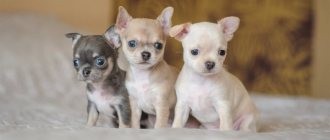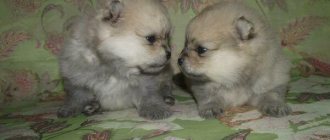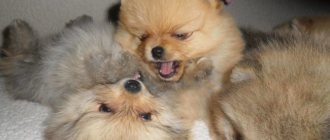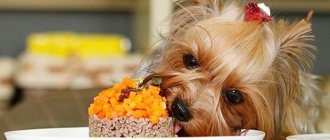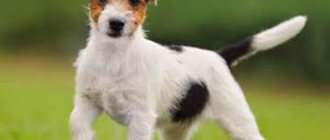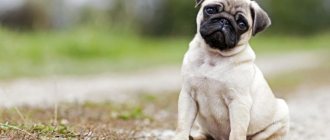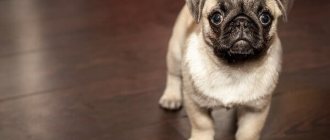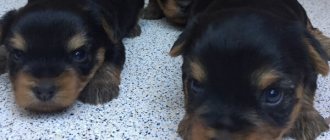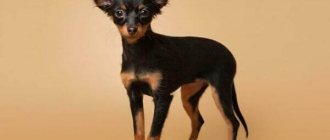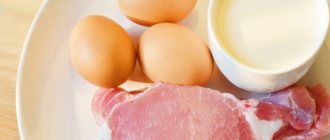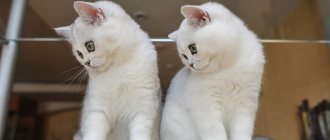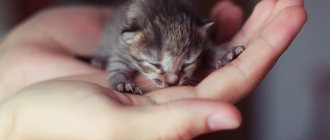The Toy Terrier is a small, cute and very active dog that belongs to the decorative breeds.
Such pets are easy to train.
They are very friendly.
As a rule, they find a common language with both family members and other animals.
Toy terriers are one of the breeds of dogs with which it is allowed to enter public transport and stay in hotels.
Photos of what newborn puppies look like
Immediately after birth, toy terrier babies are almost completely helpless; the only thing they can do is reach their mother’s nipple, actively suck and squeak.
Newborn Toys are blind, deaf, and cannot defecate on their own . Their mother helps them with this. She carefully licks the babies and eats the secretions.
Among other things, immediately after birth, toy terrier puppies lack normal thermoregulation, so they are completely dependent on external sources of heat.
The size of a newborn toy terrier is smaller than a woman's palm and resembles a newborn kitten.
Bitch after giving birth
If the bitch is unable to care for the puppies in the first few days (for example, after a caesarean section), you will have to imitate the actions of the dog by massaging the puppies' bellies with a warm, slightly damp cloth. A mother bitch coming off anesthesia, especially if she is a first-time mother, may be somewhat shocked by the appearance of puppies underneath her, and may become quite nervous when the small newborn puppies begin to crawl over her extremely painful belly. Therefore, when the bitch finally comes to her senses, return the puppies to her one at a time and observe her reaction before introducing the remaining puppies to her.
If she has had a litter before, she will most likely take them under her and will look after them normally even despite the stitch on her belly. However, a bitch who has become a mother for the first time will behave a little more warily, so sit next to her at all times. It will be good if you have an assistant to make your task easier. The point is that if the mother is restless, she needs your constant presence for several days and nights.
You can walk away for a minute and return to find that the bitch, for example, has licked and chewed off part of the umbilical cord along with the peritoneum, or has calmly chewed off the heads or limbs of her puppies. This is rather a rare and atypical behavior for a mother bitch, but you need to know about it and be prepared for it. You can also keep the puppies in the first 24 hours after a caesarean section in a box with a heating pad next to the bitch and place the puppies only for feeding. If the dog shows no interest in puppies at all, it may be sick. Call a doctor without delay.
How does it develop day by day in the first month?
| Days | Physical development and behavior change |
| 1-4 | The puppy cannot see or hear, he has no fat layer, and thermoregulation is undeveloped. During this period, the puppy produces meconium (original feces). |
| 5 | Pain sensitivity is reduced, the brain is poorly developed. |
| 6-8 | The nose becomes stained, reflexive chills appear, and active weight gain occurs. |
| 8-9 | The original weight is doubled. |
| 10-15 | The puppy's eyes begin to open, the pupil reacts to light, but the retina is poorly developed. |
| 16-18 | A fat layer begins to form, thermoregulation improves, and the puppy gradually learns to cope without additional sources of heating. |
| 19-21 | The toy terrier baby begins to hear and reacts to sound. |
| 22 | Baby teeth begin to emerge. |
| 23-24 | The sucking reflex fades, interest in solid food appears. The puppy already knows how to bite, chew, and is actively exploring the world. |
| 25-30 | Thermoregulation is fully formed, the body temperature is like that of an adult, the baby is already responding to its name, and motor activity is increasing. |
How does it develop from 1 to 12 months?
Development of a toy terrier puppy from 1 month to 1 year:
| Age (months) | Description | Size(cm) | Weight (g) |
| 1 | Newborn period. The puppy knows how to suck the mother's nipple and move its paws to get to it. The baby does not have independent thermoregulation, he does not know how to empty himself. | 6-10 | 200-650 |
| 2 | Transition period. At this age, the puppy has already opened his eyes and began to hear, is able to move independently and play, and a craving for solid food appears. Baby teeth have already appeared. | 10-14 | 320-1050 |
| 3 | Period of socialization. By this age, the puppy has already formed the basic functions of the body, active growth and weight gain continue. A daily rhythm begins to form and physical activity increases. During this period, the dog begins to understand the “laws of hierarchies.” | 14-20 | 460-1550 |
| 4 | Teeth change and the immune system begins to form. Until this age, the puppy’s immunity functioned due to beneficial substances obtained from the mother’s milk. | 18-24 | 600-1900 |
| 5-6 | Juvenile period. At this time, the puppies develop their character. Individual qualities and specific behavioral reactions. At this age, the first sexual games begin. | 20-28 | 700-2200 |
| 7 | Puberty. During this period, the Toy Terrier bitches’ eggs begin to mature and they become capable of fertilization. At the same age, the first estrus begins. | 20-28 | 800-2500 |
| 8-12 | Period of puberty. | Growth is over | Weight gain stops |
How to care?
In order for a toy terrier puppy to grow up healthy and strong, it is necessary to follow many rules when caring for it, especially in the first year of life.
What do we have to do:
- Feed correctly, and this applies to the diet and the quality of feed (if you give feed), and the amount of food.
- Be sure to ensure that the dog does not get injured, as this often happens to toy terriers due to their diminutive size and fragile bones. Don't let your puppy jump from heights or start fights with other animals.
- Remove all dangerous objects (cables, glass vases, heavy and unstable objects, household chemicals) away. All this should not be within the dog’s access area.
- Make it a habit to inspect and clean your puppy's eyes and ears daily.
- Be sure to give your pet multivitamins containing calcium and phosphorus. This is especially necessary for the baby during the period of changing teeth and setting ears.
- Never feed your dog from your plate.
- Don't let your puppy get too cold or overheated.
- Approximately once every 3 months, give her anthelmintic drugs.
- In the warm season, the dog should be treated against fleas, ticks and other parasites with special compounds.
- Take the time to find a good veterinarian who can provide immediate assistance if necessary. But remember, the chosen specialist must understand the characteristics of the breed.
- Take your pet for walks regularly, he simply needs it, because toy terriers are very active and mobile.
- Be sure to toilet train your puppy and don’t let him relieve himself anywhere, as this will eventually turn into a problem.
- Approximately once every 2-3 months, the toy terrier should be bathed, following all the rules.
- From the very first days of being in your home, accustom your dog to a collar and leash. This is necessary for the safety of the animal.
Toy Terrier - features of the breed
The Toy Terrier is one of the smallest dogs in the world. There are two official varieties of the breed: Russian and English Toy, the second being the ancestor of the first.
Features of the breed are the first theoretical material that a potential owner should study. Toy terriers are special dogs that require a responsible approach and hyper-custody. Toy terriers literally break records in the field of self-injury, dental and skin problems.
By studying the characteristics of the breed and feeding standards for your future pet in advance, you can avoid many common mistakes. The basis of care is proper feeding, although it cannot be called the most important aspect. Care is a comprehensive measure that allows the dog to remain healthy and beautiful.
What to feed for the first 3 months?
Products necessary for a toy terrier puppy:
- Cottage cheese, kefir, yogurt.
- Boiled egg yolk (once a week).
- Boiled lean beef.
- Boiled chicken.
- Boiled or scalded beef or chicken liver.
- Beef heart.
- Boiled or raw vegetables (cabbage, greens, zucchini, carrots, beets, fruits).
- Premium dry food designed specifically for toy terriers. Food is selected taking into account the age of the dog.
- Porridge (buckwheat, oatmeal, rice, etc.).
Under no circumstances should you give your puppy spicy, salty, smoked foods, or beans..
For more complete information about what can be given to a toy terrier and what cannot, read here.
Prohibited Products
There are foods that are not acceptable as dog food:
- fatty pork;
- raw chicken;
- smoked meats and sausages;
- freshwater and any raw fish;
- ready-made sauces (mayonnaise);
- fried foods (cutlets, etc.);
- pasta and flour products.
Taking into account all the nuances and characteristics of the breed, you can easily create a feeding diet and provide the puppy’s body with the necessary nutrients.
How to feed correctly and how often?
Proper care of a small toy terrier involves 4 meals a day in the first 3 months. Subsequently, the puppy is transferred to 3 meals a day.
For a period of up to 6 months, portions for a toy terrier should be no more than 30 grams . Never overfeed your baby!
After six months, the puppy can be fed like an adult dog, that is, 2 times a day, and the serving size will already be 50 g.
Weekly menu
Monday:
- Breakfast - low-fat cottage cheese or kefir,
- Lunch - buckwheat porridge with boiled liver,
- Dinner - oatmeal with boiled heart.
Tuesday:
- Breakfast - yogurt or cottage cheese.
- Lunch - wheat porridge with boiled chicken.
- Dinner - boiled fish with seaweed.
Wednesday:
- Breakfast - boiled egg with low-fat broth.
- Lunch - boiled beef (not fatty) with carrots.
- Dinner - oatmeal porridge with liver.
Thursday:
- Breakfast: cottage cheese or kefir.
- Lunch - 50 dry food designed specifically for toy terriers.
- Dinner - boiled rice with stewed beets and a piece of chicken.
Friday:
- Breakfast - low-fat chicken broth with boiled carrots.
- Lunch - buckwheat with boiled chicken liver.
- Dinner: yogurt or kefir.
Saturday:
- Breakfast - a piece of boiled fish.
- Lunch - boiled oatmeal with beef.
- Dinner: cottage cheese or kefir.
Sunday:
- Breakfast: yogurt or kefir.
- Lunch: beef liver with rice.
- Dinner - zucchini or cabbage.
Types of feeding
The best way to feed a toy terrier, you can find the answer here. You can feed your dog with natural products and ready-made dry or wet factory-made food. The choice of type of food for a toy terrier is mainly influenced by the dog owner’s free time and the ability to create a diet.
Feeding dry prepared food
Ready-made dry food is a completely balanced diet. No additional bait is required with this diet. You can feed your pet with dry or soaked granules.
Advantages of dry feeding:
- Prevention of dental problems (chewing “drying” removes plaque and stone that cause tooth damage).
- Ability to control calories consumed.
- Convenience (no need to frequently buy groceries, plan your diet, cook, you can take it for a walk or on a trip).
- Hygiene (dry food will not stain the dog, its bedding and the owner).
- Consistency and balance of composition, which has a positive effect on digestion and bowel regularity.
- A variety of foods covering any age, size, lifestyle.
When feeding dogs dry food, a constant supply of water is required. This will prevent the development of urolithiasis.
Economy class feed
Using dry feeding, it is strictly forbidden to treat your toy terrier with economy class granules. Such feeds have one advantage. They are affordable for everyone. But there is no meat in cheap pellets. A large share of the product consists of pea flour and other components that are difficult for digestion and animal health: ground skins, bones, artificial stabilizers, dyes, flavors. There is no benefit from feeding cheap dry food. Granules of the economy category: Pedigree, Chappie, Darlings, Happy Dog - fill the volume of the stomach, only creating the illusion of satiety.
Premium class
Dry food of medium, premium class, more expensive. They are affordable, have acceptable quality, but are poor in vitamins. This includes products from the brands Proplan, Bozita, Royal Canin, and Hills. Dogs live well on this diet if additional fortified supplements are added and portions are increased. Savings here are questionable, since you will have to purchase the necessary components.
Super Premium class (holistic)
Super Premium food, so-called holistic. Expensive. They consist only of the freshest natural high-quality varieties of meat, vegetables, fruits, and are even suitable for human nutrition. Such granules contain the entire complex of substances necessary for the harmonious development and growth of a dog: nutritional components, vitamins, minerals, probiotics. In the production of Super Premium food, dyes and ingredients that cause an allergic reaction are not used that are harmful to animal health. Korma Akana, Canida, Orijen, Grandorf, Pronature are leaders in the holistic rating.
From all the variety of ready-made food, you can choose the one that will be useful to your dog and will suit her taste. The only drawback of dry feeding is the high cost of quality products from well-known brands. But, given the miniature size of toy terriers, not much food is needed.
What should a quality dry food contain?
The components of a good food should be certain components. High quality product includes:
- at least five sources of carbohydrates (for example, rice, rolled oats, flax seed);
- more than two sources of protein (beef, fish, chicken);
- at least three types of fruits and vegetables;
- enzymes and probiotics (bacteria that help suppress harmful microflora in the intestines, digest food, and absorb nutrients);
- vitamin and mineral supplements.
Advice: buy dry food only in specialized stores, in original, factory packaging. You cannot take loose pellets (they may be expired) on the street, in open pavilions, kiosks that do not maintain the appropriate humidity and temperature storage conditions.
If your toy terrier tends to consume small amounts of water, it is better to prefer canned food. This will prevent urinary system diseases and dehydration.
Mixing dry and wet food or canned food is allowed if they are produced by the same brand.
Reviews from veterinarians
All animals have different needs and body characteristics. Not every most expensive and advertised product is suitable for your dog. Let's take a look at some veterinarian recommendations for choosing the best dog food.
L. Rudnitskaya, veterinarian: “When purchasing, pay attention to the amount of protein indicated on the package. The high protein content confirms the high quality of the product. The grains listed in the first place allow us to classify the feed as an economy product. Cereals are poorly digested, have low nutritional value, and only dull the feeling of hunger by filling the stomach. The presence of preservatives, dyes, and food flavorings indicates the low quality of food. These substances have carcinogenic properties. Undermining the dog's health, they can cause anemia, allergies, and itchy skin.
Super Premium granules contain natural antioxidants, herbs, probiotics, and vitamins. This also includes by-products of the highest category: liver, heart of cattle, poultry.
Sometimes even the best ready-made food harms the dog. An allergic reaction caused by any component indicates intolerance to any ingredient. In this case, they select another food or switch the animal to natural food.
Holistic class products include several types of meat, vegetables, fruits, digestive enzymes that help faster and better digestion of food, pro- and prebiotics, and fortified complexes. Such food is beneficial to animals and will not harm human health. For feeding toy terriers, I recommend the following brands: Go Naturel, Orijen, Earthborn.” https://zoolog.guru/domashnie-zhivotnye/sobaki/pitanie-sobak/mnenie-veterinarov-kakoy-korm-dlya-sobak-samyy-luchshiy.html
V. Olshansky, veterinarian: “Purina PRO PLAN complete food for dogs provides complete nutrition. When feeding, no additional nutrients are required. The company produces healthy snacks for treating pets, and special biscuits for training. A line of food has been developed for animals with sensitive digestion. The granules do not contain components that cause fat accumulation and the formation of excess weight. Provide a regular feeding regimen and daily intake rates. The food is suitable for feeding heavy eaters - toy terriers. And the presence of healthy treats will be appreciated by owners who love to pamper their pet with goodies.” https://www.proplan.ru/dog/article/pochemu-sobakam-ne-podhodit-domashnyaya-eda/
S. Andreichenko, veterinarian: “Manufacturers of economy feed advertise their products very competently, correctly promoting their product among consumers. Not every owner thinks about their pet’s diet and food composition. Many additives that attract animals are added to the products. Seeing the appetite with which a dog eats granules, inexperienced owners conclude that the food is good. Economy class granules are designed for a wide range of consumers. They are sold in any supermarket and even in a small grocery store. People who don’t know, who have little interest in what goes into it, buy it. There is demand, which means there is supply. As long as they buy, they will produce. This food is not suitable for feeding miniature dogs, including toy terriers. There is no need to skimp on feeding a small dog: it doesn’t need much.”
Features of feeding natural food
Natural feeding has its advantages. Such food is more natural, natural. It allows you to diversify the dog’s menu as much as possible. But, having chosen this type of feeding toy, you need to know that you cannot store cooked food. The bowl is removed 15 minutes after eating, and the uneaten remains are thrown away.
Experienced breeders, in response to the question of what is the best way to feed adult toy terriers from homemade food, advise choosing only fresh, good quality food. Be sure to supplement your diet with vitamins and minerals, especially in autumn and spring.
2/3 of a dog’s diet should consist of protein components, represented by meat and dairy products, fish, eggs, and offal. 1/3 - cereals, the rest - fruits and vegetables.
You can switch from dry food to natural food. But they do this by gradually replacing the usual product. Completely exclude it from the diet after 10–14 days.
Sample menu for an adult toy terrier for a week with two meals a day:
| Day of the week | Dish |
| Monday | Breakfast: finely chopped beef or minced veal, rice, herbs. Dinner: cottage cheese with honey, egg yolk, flax oil. |
| Tuesday | Breakfast: rabbit meat, oatmeal, greens. Dinner: sea fish, fermented baked milk. |
| Wednesday | Breakfast: beef heart, finely chopped, Dinner: sea fish, grated apple, carrots. |
| Thursday | Breakfast: veal, rice, greens, stewed zucchini. Dinner: sea fish, sauerkraut, rye crackers. |
| Friday | Breakfast: beef liver, rolled oats, grated pumpkin stew, wheat germ oil. Dinner: low-fat cottage cheese with honey, grated pear. |
| Saturday | Breakfast: chicken breast (minced meat), greens, buckwheat porridge, corn oil, peach slices. Dinner: sea fish, boiled beets, carrots, greens. |
| Sunday | Breakfast: beef slices, egg yolk, rice, grated zucchini, greens, sesame oil. Dinner: curdled milk, banana slices, pears. |
What vaccinations should I get? Vaccination schedule
You should know that the first vaccination for a toy terrier puppy is given no earlier than 2-2.5 months . This vaccination is carried out in two stages with an interval of 7-10 days.
At 6-6.5 months, another increase in BIOVAC is made; it includes weakened bacteria of 18 pathogens. This is why it can be difficult for a dog to tolerate.
21 days after the BIOVAC vaccination, the dog is vaccinated against rabies..
Subsequently, all vaccinations are repeated annually throughout the pet’s life.
How to bathe properly?
The puppy can be washed 2 weeks after all vaccinations. But the ideal age is 6 months.
Rules for bathing a toy terrier puppy:
- Bathing should not be too frequent, as this can have a detrimental effect on the baby's skin and coat.
- When bathing, use only special products for dogs (shampoos and conditioners). If the package has instructions on how to dilute the product, be sure to do so.
- When bathing a puppy, place a special mat at the bottom of the bath or container so that the dog’s paws do not move apart.
- The water for swimming should not be 38-39 degrees.
- Before bathing, roll 2 cotton balls and cover the animal’s ear canals with them to prevent water and shampoo from getting there.
- After swimming, exclude all drafts.
- After bathing, dry the puppy with a terry towel and let it dry in a warm place.
Toy Terrier nutrition
What to feed the animal—natural food or dry food—depends on the owner. If the owner decides in favor of regular foods, it is important that the toy’s diet is balanced. Small terriers can be given:
- lean meat;
- sour milk;
- offal (except lungs, kidneys and udder);
- vegetables.
Everything should be either boiled or scalded with boiling water.
If the owner has a preference for dry food, it is worth choosing products labeled “for small breeds.” It is also necessary to take into account the age and health of the terrier.
Important! Regardless of what exactly the cat eats, natural or food, he should always have access to clean drinking water.
The appearance of baby teeth and their cleaning
Like other dogs, the Toy Terrier has 42 teeth. 20 on the upper jaw and 22 on the lower jaw.
IMPORTANT!
Puppies' first teeth begin to appear two weeks after birth.
First, the primary canines erupt, then the premolars, then the incisors, and lastly the molars. At the same time, they appear not one at a time, as in a person, but 6 pieces at once, both on the upper and lower jaw.
By the age of 2 months, 28 baby teeth can already be seen in the baby’s mouth..
At home, you can brush your toy terrier’s teeth using a special brush that will not only clean the teeth, but also massage the gums.
To do this, place the brush on your finger, lift the dog’s upper lip and gently brush the teeth with massaging circular movements. When cleaning, you should only use a special paste for dogs .
The procedure itself is recommended to be carried out 1-2 times a month.
Your puppy's oral hygiene should be given close attention, treated promptly, and bite development should not be missed.
Appearance
The Russian Toy Terrier is an elegant dog with long straight legs and lean muscles. His neck is elongated and elegant. The tip of the nose, depending on the color of the toy, is brown or black. The ears of such dogs are erect, thin, set high and have the shape of an isosceles triangle with pointed or rounded tips.
Among Russian Toy Terriers there are two variations: smooth-haired and long-haired. The first have: the coat is shiny and short, close to the body, there is no undercoat or bald patches; in the second, the coat is moderately long (3–5 cm), can be somewhat wavy or straight, frames the body without hiding its contours.
The color is usually uneven: on the face, chest and limbs there are spots lighter than the main tone. The color of the coat, as well as its shades, is variable: from fawn to black. The color is rich.
Gender is weakly expressed outwardly, however, it is clearly manifested in the behavioral line.
Is it necessary to dock the tail and when to do it?
In the modern world, standards requiring ear cropping cause a lot of controversy among veterinarians, breeders and dog handlers.
Most foreign shows have already abandoned this standard and accept dogs with undocked tails..
Some went even further and stopped allowing dogs with docked ends into exhibitions.
As a rule, tail docking for a toy terrier puppy is carried out on the 3rd day after birth..
How to train correctly and what commands to teach?
The first thing to remember is that a toy terrier is a dog, not a child, and should be treated as such.
What do we have to do:
- Accustom the puppy to its name.
- Don't let your dog growl at you. Stop this action immediately.
- Under no circumstances should you allow someone to enter the door first, as this is a sign of leadership, and the leader should always be the owner.
- Under no circumstances should you take your dog into your bed. If a decorative dog sleeps in its owner’s bed, it begins to perceive him as an equal.
- Don't spoil your dog. Under no circumstances should you speak kindly to him or console him when the dog growls at you or behaves badly. Otherwise, he will take it as encouragement.
- Try to teach the toy terrier basic commands such as: “Ugh,” “No,” “Place,” “Come.”
Pet training
Thanks to his intelligence, training a toy terrier is not very difficult. With persistence, consistency and goodwill, the pet quickly masters basic commands and fulfills requirements with special zeal and desire. You need to learn to follow commands at home, on walks, so that the animal does not have the association that commands need to be obeyed in the apartment.
In order for the little toy to listen to the requirements and adequately respond to training, it is necessary to realize the activity and ebullient energy of the animal during walks, then it will be easier to control it. From puppyhood, it is necessary to accustom the toy to a sleeping place, a bowl, a tray, and to the norms of behavior in the apartment and on the street.
You need to immediately let the puppy know who is boss, wean him off the habit of biting during games, throwing himself into your arms in a fit of joy, and other “puppy” pranks, otherwise it will become more difficult to raise the dog later. Ease of care and training makes representatives of this breed easy to maintain and train, even for inexperienced owners.
To successfully train a dog, take into account age characteristics and sensitive periods for learning commands.
How to distinguish a boy from a girl?
The easiest way to find out the gender of a newborn toy terrier puppy is to examine the baby's genitals..
Examine the area just below the animal's navel.
A male puppy will have a small protrusion here covered with a tuft of fur . This area is clearly visible, you can't go wrong.
Also, between the hind legs of small males there is another tuft of hair; after 8 weeks of age, the testicles will be located here.
In female puppies, the characteristic tuft of hair is absent, and under the tail there is a small seal in the form of a button . This is the genital slit.
How to choose a puppy?
If you decide to buy a toy terrier puppy, then you should pay attention to its behavior.
NOTE!
A healthy puppy is active, mobile, eats well, is interested in its surroundings, is inquisitive and cheerful.
The second important factor is an excellent appetite; a healthy puppy always eats well, licks the bowl and will not miss any tasty morsel.
A healthy pet should not have any discharge from the ears, nose, anus or genitals . Before purchasing, carefully examine the baby to make sure everything is okay with him.
Pay attention to the conditions in which the puppies are kept. The place should be clean, spacious and free of drafts. A tray or diaper is required.
If the puppy shakes its head or scratches its ears. This may indicate the presence of parasites.
Touch the puppy's ear; it shouldn't be hot and red..
Pay attention to your joints; healthy joints are always strong and flexible. A healthy dog moves forward easily and cheerfully, and in no case limps.
Tray training
During the daytime, not all owners have the opportunity to walk with their small pets. To avoid troubles in the apartment in the form of puddles of urine, piles of excrement, you need to learn: how to accustom a toy terrier to the tray as quickly as possible. To do this, you should get special diapers, which have an upper absorbent and lower waterproof layer (it is also possible to use regular paper and newspapers).
If the pet begins to behave anxiously and sit down, it should be moved to the tray so that it can relieve itself. An owner who knows how to toilet train a toy terrier will certainly praise his pet for every successful bowel movement in the place designated for this purpose.
It is strictly forbidden to punish (scold, beat) a puppy.
